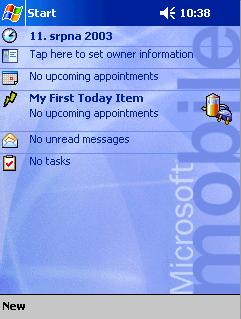
Introduction
When writing a custom today item, we always spend a lot of time on writing code that is repeatable and even less "user-friendly". I've tried to wrap the standard today custom item into a class which could be reused and is more comfortable for developers.
Background
The purpose of doing this was to write a class which would be similar to the MFC CWnd class. This class wraps the basic functionality of a today custom item and defines the basic behavior overridable by the developer.
Abstract
The class CTodayWindow is defined as follows:
class CTodayWindow
{
public:
HWND m_hWnd;
CTodayWindow();
CTodayWindow(HINSTANCE hInstance,
LPCTSTR lpszClassName, LPCTSTR lpszWindowName);
virtual ~CTodayWindow();
BOOL Create(HWND hWndParent,
DWORD dwStyle = WS_VISIBLE | WS_CHILD);
void RefreshWindow(BOOL bShow = FALSE);
BOOL SetIcon(UINT uID, int xDrawAt = 2, int yDrawAt = 0);
void SetItemHeight(int nHeight);
void SetClassInfo(LPCTSTR lpszClassName, LPCTSTR lpszWindowName);
void SetInstance(HINSTANCE hInstance);
HWND GetParent() {return m_hParentHwnd;};
int GetItemHeight() {return m_nHeight;};
HINSTANCE GetInstance() {return m_hInstance;};
HICON GetIcon() {return m_hIcon;};
LPCTSTR GetClassName() {return m_lpszClassName;};
LPCTSTR GetWindowName() {return m_lpszWindowName;};
void RegisterTodayClass(WNDPROC wndProc);
void UnregisterTodayClass();
virtual LRESULT CALLBACK TodayWndProc(UINT uMsg,
WPARAM wParam, LPARAM lParam);
protected:
BOOL m_bInitialRefresh;
int m_nHeight;
POINT m_pointIconPos;
HWND m_hParentHwnd;
HICON m_hIcon;
HINSTANCE m_hInstance;
LPCTSTR m_lpszClassName;
LPCTSTR m_lpszWindowName;
COLORREF m_crTodayText;
HFONT m_hNormalTodayFont;
HFONT m_hBoldTodayFont;
virtual void DrawTodayIcon(HDC hDC, int xPos, int yPos);
virtual void GetTodayDefaults();
virtual int OnCreate(LPCREATESTRUCT lpCreateStruct);
virtual void OnDestroy();
virtual void OnPaint(HDC hDC);
virtual void OnEraseBkgnd(HDC hDC);
virtual void OnTodayCustomQueryRefreshCache
(TODAYLISTITEM *pTodayListItem, BOOL *pResult);
virtual BOOL OnTodayCustomClearCache(TODAYLISTITEM *pTodayListItem);
virtual void OnLButtonUp(UINT nFlags, POINT point);
virtual void OnLButtonDown(UINT nFlags, POINT point);
virtual void OnSettingChange(UINT nFlags, LPCTSTR lpszSection);
virtual LRESULT OnNotify(UINT nID, NMHDR* pNMHDR);
virtual LRESULT OnMessage(UINT uMsg, WPARAM wParam, LPARAM lParam);
};
Basic class information
As you can see, I've pre-defined recently used messages into message handlers which are easy-to-use in derived classes. You don't need to write anymore code in WndProc and do the same stuff again and again. The main message loop is defined in:
LRESULT CALLBACK TodayWndProc(UINT uMsg, WPARAM wParam, LPARAM lParam);
This method handles some basic messages, and I've defined some virtual methods you can override. From my point of view, the most commonly used message are:
WM_CREATE WM_DESTROY WM_PAINT WM_ERASEBKGND WM_LBUTTONDOWN WM_LBUTTONUP WM_TODAYCUSTOM_CLEARCACHE WM_TODAYCUSTOM_QUERYREFRESHCACHE WM_SETTINGCHANGE
These messages have their own message handlers. Special behavior has the following handlers:
WM_PAINT which firstly tries to draw the icon assigned to the window. This icon has to be set by the SetIcon method. WM_TODAYCUSTOM_QUERYREFRESHCACHE which recognizes the initialization of the today custom item and sets the correct item height stored in m_nHeight and set by the SetItemHeight method. WM_ERASEBKGND message handler OnEraseBkgnd draws the transparent background for the item. This standard behavior can be overridden by the developer.
Creation of a today custom item window is handled in the:
BOOL Create(HWND hWndParent, DWORD dwStyle = WS_VISIBLE | WS_CHILD)
method. This method creates a window with the following attributes:
- style passed in the
dwStyle parameter - parent window passed in the
hWndParent parameter - rectangle initially set to left = 0, top = 0, width = screen width, height = 0
- class and window name passed as attributes in the constructor or set by the
SetClassInfo method
This class provides a today custom item window class (un)registration as well.
- Class registration is provided by the
void RegisterTodayClass(WNDPROC wndProc) method. The parameter is the main window procedure defined in your today custom item application. - Class unregistration is provided by
void UnregisterTodayClass()
Using the code
Using this class is very simple. Just derive your own class from the CTodayWindow class and define your today custom item behavior. Then, write the main application logic as generally known (for example, from MSDN). In the DLLMain function, create an instance of your class when attaching the library to process. Set the common attributes like item height, item icon etc. In the InitializeCustomItem function, register your class and create the today custom item window by calling the Create method. And that's all. Here is the sample code:
static CMyToday* myToday;
BOOL APIENTRY DllMain(HANDLE hModule, DWORD dwReason, LPVOID lpReserved)
{
switch (dwReason)
{
case DLL_PROCESS_ATTACH :
myToday = new CMyToday((HINSTANCE)hModule,
_T("MyTodayClass"), _T("MyTodayWnd"));
myToday->SetItemHeight(40);
myToday->SetIcon(IDI_APP_ICON);
break;
case DLL_PROCESS_DETACH :
myToday->UnregisterTodayClass();
delete myToday;
break;
}
return TRUE;
}
HWND InitializeCustomItem(TODAYLISTITEM *ptli, HWND hWndParent)
{
myToday->RegisterTodayClass((WNDPROC)WndProc);
myToday->Create(hWndParent, WS_VISIBLE | WS_CHILD);
myToday->RefreshWindow(TRUE);
return myToday->m_hWnd;
}
LRESULT CALLBACK WndProc(HWND hWnd, UINT uMsg, WPARAM wParam, LPARAM lParam)
{
return myToday->TodayWndProc(uMsg, wParam, lParam);
}
This member has not yet provided a Biography. Assume it's interesting and varied, and probably something to do with programming.
 General
General  News
News  Suggestion
Suggestion  Question
Question  Bug
Bug  Answer
Answer  Joke
Joke  Praise
Praise  Rant
Rant  Admin
Admin 








![Rose | [Rose]](https://codeproject.global.ssl.fastly.net/script/Forums/Images/rose.gif)

